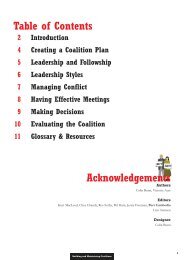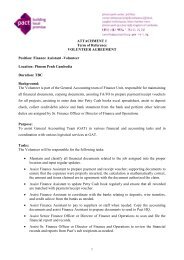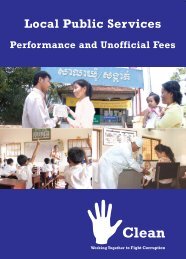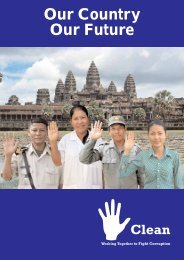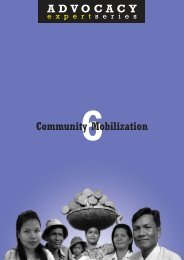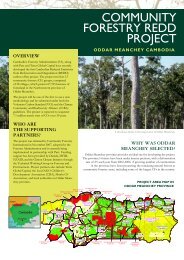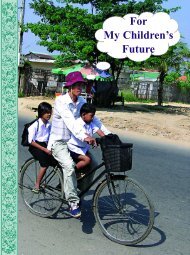Advocacy in Cambodia: Increasing Democratic ... - Pact Cambodia
Advocacy in Cambodia: Increasing Democratic ... - Pact Cambodia
Advocacy in Cambodia: Increasing Democratic ... - Pact Cambodia
You also want an ePaper? Increase the reach of your titles
YUMPU automatically turns print PDFs into web optimized ePapers that Google loves.
court<strong>in</strong>g the<br />
media<br />
The media campaign – the development of a media message, its presentation, and<br />
the identification and target<strong>in</strong>g of specific audiences – plays an important role <strong>in</strong><br />
generat<strong>in</strong>g support for and sometimes aga<strong>in</strong>st a cause.<br />
Increas<strong>in</strong>g <strong>Democratic</strong> Space<br />
As mentioned <strong>in</strong> the <strong>in</strong>troduction of this<br />
report, one of the aims of advocacy is to draw the<br />
attention of policymakers and the general public<br />
to a cause and generate sympathy for it. The media<br />
campaign – the development of a media message,<br />
its presentation, and the identification and<br />
target<strong>in</strong>g of specific audiences – plays an<br />
important role <strong>in</strong> generat<strong>in</strong>g support for and<br />
sometimes aga<strong>in</strong>st a cause. For centuries,<br />
“traditional media” referred to the pr<strong>in</strong>ted word<br />
– newspapers, books and magaz<strong>in</strong>es. But rapid<br />
development of technology <strong>in</strong> the late-20 th century<br />
- radio, television, and the Internet - has greatly<br />
expanded the reach of the media and <strong>in</strong>creased<br />
the use of images to convey messages.<br />
Overview of the <strong>Cambodia</strong>n Media<br />
Accord<strong>in</strong>g to a report published by SIDA and<br />
Forum Syd <strong>in</strong> May 2000 entitled Trapped <strong>in</strong> the<br />
Past, Seek<strong>in</strong>g Out a Future: A Study on the<br />
<strong>Cambodia</strong>n Media Sector, the <strong>Cambodia</strong>n media<br />
is small and suffers from a general lack of<br />
resources, <strong>in</strong>clud<strong>in</strong>g adequate tra<strong>in</strong><strong>in</strong>g for<br />
journalists, updated technology, <strong>in</strong>stitutional<br />
policies, and structures promot<strong>in</strong>g diversity and<br />
<strong>in</strong>dependence. In addition, there is a limited<br />
number of media consumers and a limited level<br />
of disposable <strong>in</strong>come <strong>in</strong> the country. As a result,<br />
few companies <strong>in</strong>vest <strong>in</strong> advertis<strong>in</strong>g and salaries<br />
for journalists are low. This discourages skilled<br />
<strong>in</strong>dividuals from enter<strong>in</strong>g the <strong>in</strong>dustry.<br />
The television media is l<strong>in</strong>ked to the<br />
government or the <strong>Cambodia</strong>n People’s Party and<br />
focuses ma<strong>in</strong>ly on enterta<strong>in</strong>ment <strong>in</strong>stead of<br />
<strong>in</strong>formation. It has little emphasis on public<br />
service and does not reach the public <strong>in</strong> the rural<br />
areas. Similarly, radio stations also often lack<br />
<strong>in</strong>dependence from political parties and offer more<br />
enterta<strong>in</strong>ment than education. Even so, radio is<br />
an important means of reach<strong>in</strong>g the public and<br />
some radio stations are beg<strong>in</strong>n<strong>in</strong>g to reach the<br />
prov<strong>in</strong>ces, where coverage has been m<strong>in</strong>imal.<br />
Although newspapers can occasionally be<br />
shut down or threatened for political reasons, the<br />
pr<strong>in</strong>t media does tend to enjoy relative freedom<br />
of expression. There are over 200 licensed<br />
newspapers and magaz<strong>in</strong>es. Khmer newspapers,<br />
such as Koh Santepheap and Rasmey<br />
Kampuchea, are <strong>in</strong>creas<strong>in</strong>gly the first to cover a<br />
story, which subsequently appears <strong>in</strong> an English<br />
language paper. As with television and radio<br />
however, pr<strong>in</strong>t media <strong>in</strong> the prov<strong>in</strong>ces is still<br />
scarce.<br />
Strategies Used by Advocates<br />
Civil society organizations work<strong>in</strong>g <strong>in</strong> sectors<br />
reviewed <strong>in</strong> this report are currently us<strong>in</strong>g a variety<br />
of media strategies, an <strong>in</strong>dication that the sectors<br />
are becom<strong>in</strong>g more mature. Some of the most<br />
common strategies <strong>in</strong>clude distribution of press<br />
releases, establishment of relations with reporters,<br />
and <strong>in</strong>vitation of broadcast and pr<strong>in</strong>t media<br />
representatives at events. A small number of<br />
organizations also employ more sophisticated<br />
strategies such as tra<strong>in</strong><strong>in</strong>g reporters on sectorrelated<br />
issues, tak<strong>in</strong>g them on field trips, and<br />
sett<strong>in</strong>g up Internet websites.<br />
Press Releases and Press Conferences<br />
The most common media strategies be<strong>in</strong>g<br />
used by NGOs <strong>in</strong> <strong>Cambodia</strong> today are press<br />
releases and press conferences. Press releases are<br />
one-page summaries with a few important pieces<br />
of <strong>in</strong>formation that organizations distribute to<br />
newspapers and broadcast stations to publicize an<br />
event or situation. The objective is to get the media<br />
to pr<strong>in</strong>t or broadcast the <strong>in</strong>formation so that it can<br />
be spread to a wider audience. Press releases are<br />
often used as a way to get journalists to attend an<br />
event, such as a conference or demonstration.<br />
Press conferences are similar to press releases <strong>in</strong><br />
that journalists are <strong>in</strong>vited to receive similar<br />
<strong>in</strong>formation about an event or situation. Press<br />
conferences have the added benefit of provid<strong>in</strong>g<br />
journalists with an opportunity to <strong>in</strong>teract with<br />
speakers directly.<br />
Dur<strong>in</strong>g the lobby<strong>in</strong>g of the Commune Council<br />
Election Law, EMOs prepared regular press<br />
releases to express their dissatisfaction with the<br />
legislative process and to report the f<strong>in</strong>d<strong>in</strong>gs of<br />
their public polls. EMO representatives<br />
acknowledge that their media strategy generated<br />
38





